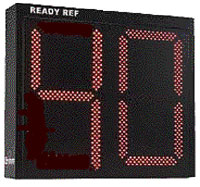NCAA News Archive - 2008
« back to 2008 | Back to NCAA News Archive Index
|
The NCAA News
The clock changes that were implemented for the 2008 college football season show a balancing effect on the game through the first six weeks of play in the Football Bowl Subdivision.
 The rule that changed the timing of the game when a ball carrier goes out of bounds has helped shorten games by about 14 minutes on average. The game clock still stops when the runner is ruled out of bounds, but it starts again on a signal from the referee after the ball is marked at the new spot on the field. The only exception is the last two minutes in each half.
The rule that changed the timing of the game when a ball carrier goes out of bounds has helped shorten games by about 14 minutes on average. The game clock still stops when the runner is ruled out of bounds, but it starts again on a signal from the referee after the ball is marked at the new spot on the field. The only exception is the last two minutes in each half.
In 2007, a typical FBS game lasted three hours, 22 minutes. This season, games are being completed in an average of 3:08.The other new rule is the 40/25-second play clock system designed to help standardize the pace of play. This season, after a play ends, the offense has 40 seconds to snap the ball.
The play clock is set at 25 seconds after administrative stoppages (for example, after injuries or change of possession). Previously, offenses had 25 seconds to run a play, but the play clock wouldn’t start until the referee’s signal.
“What has happened is the rule starting the clock on the referee signal after the ball goes out of bounds has had the impact of shortening the game, but the 40-second play clock has had the impact of adding plays back to the game,” said Rogers Redding, the NCAA secretary-rules editor for football. “My sense is those two things are balancing out.
 The average number of plays in FBS games has dipped minimally from about 143 in 2007 to about 135 through six weeks in 2008. In effect, each team is snapping the ball one fewer time per quarter.
The average number of plays in FBS games has dipped minimally from about 143 in 2007 to about 135 through six weeks in 2008. In effect, each team is snapping the ball one fewer time per quarter.
So are a few less plays harmful or helpful to the game?
“It depends on your point of view,” Redding said. “Defensive coaches may love it if they have less plays to deal with.”
There have been some isolated cases where coaches have complained about the state of the game, but for the most part coaches are adjusting to the clock rules. Some teams are going to no-huddle offenses, which picks up the pace of play.
“It has been pretty quiet from the coaches,” Redding said. “There certainly isn’t a firestorm like a couple of years ago (when the game clock started on kickoffs and after changes of possession). People have adjusted their strategy to meet the situation.”
| Watch what other rules changes were made in the NCAA Rules of the Game feature. |
Another area being monitored is the average number of points scored and total offense. Last season, offenses averaged 28.4 points and gained 392.8 yards per game, both all-time highs at the FBS level.
This year, teams are averaging 27.9 points and 377.6 yards of total offense. Traditionally, those numbers tend to drop as teams play more conference games. But so far, two of the conferences are on opposite ends of the spectrum.
In the Southeastern Conference, teams are scoring 26.2 points a game and averaging 354.0 yards of total offense. Those numbers were 30.3 and 385.9 in 2007.
The Big 12 Conference is currently averaging 39.4 points; and 448.0 yards. A year ago, the league averages were 33.4 and 438.1.
The NCAA Football Rules Committee, which strives to achieve balance between offense and defense, will sort through the numbers in January to see if any adjustments need to be made.

